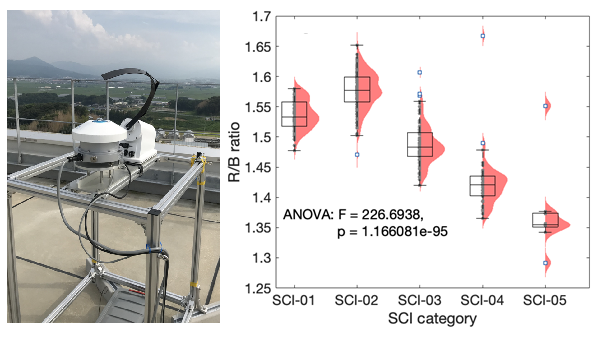Professor KUME Atsushi and his research group have discovered that the color of the sky as perceived by plants changes daily
They have modeled the factors that determine the solar spectrum by classifying the colors observed throughout the day.
POINT
- For evaluating the impact of the solar spectrum*1 on plants, high-precision observation of solar radiation and data modeling are essential.
- They have successfully developed a new machine learning model that can reproduce daily solar radiation characteristics (clustering) from simple observational data.
- Changes in solar radiation characteristics due to climate change are expected to have a broad impact on plant growth, biological responses, and solar power generation.
SUMMARY
Plants not only use solar radiation for photosynthesis but also utilize the ratio of various light wavelengths (color balance) as environmental signals, which they detect through the response of photoreceptors. The color balance is influenced by factors such as the atmosphere, clouds, and the height of the sun. However, this information has not been systematically organized in plant physiological ecology, and existing solar radiation models for biological responses have not included color balance and light quality and, therefore, do not reflect actual conditions.
Using a newly developed rotating shadow band spectroradiometer, they conducted long-term observations of the solar spectrum and analyzed one year of data to determine how the daily average solar spectrum can be classified. They identified five different classification categories ranging from clear to cloudy conditions and developed a new machine learning model that can reproduce these classifications from simple observational data such as solar radiation intensity and humidity.
Amila Nuwan Siriwardana, a third-year doctoral student at the Graduate School of Bioresource and Bioenvironmental Sciences, Kyushu University, and Professor KUME Atsushi from the Faculty of Agriculture applied agglomerative hierarchical clustering on cumulative Euclidean distance matrices to solar spectrum observation data. They identified five solar characteristic clusters (SCI) with spectral shifts from red to blue. Additionally, they developed a machine learning model that can reproduce these SCIs using easily obtainable environmental variables such as solar diffuse ratio, global solar radiation, solar radiation variability, solar altitude, and atmospheric humidity.
This innovative approach enables the modeling of differences in solar wavelength ratios dependent on weather conditions in various locations around the world, and it is expected to promote research on light responses in plants and ecosystem functions.
The results of this study were published in the academic journal "Ecological Informatics" by Elsevier on Wednesday, December 11, 2024.
Comment from the Researcher

Right: Example of color balance (Red/Blue) changes by cluster
This research was conducted using long-term observation data collected from the rooftop of the Faculty of Agriculture building at Ito Campus, despite the restrictions on research activities due to the COVID-19 pandemic. The Itoshima Peninsula has a high proportion of cloudy days, significantly impacting agricultural production. However, I was surprised to find that the distribution of light wavelengths and sky color balance perceivable to plants changes significantly.
(Amila Nuwan Siriwardana, third-year doctoral student)
GLOSSARY
*1 Solar Spectrum
The wavelength distribution of light from the sun changes as it passes through the Earth's atmosphere. The difference between the solar spectrum and the solar radiation spectrum observed on the ground reflects the changes that occur during this passage through the atmosphere.
Paper Information
Journal: Ecological Informatics
Title: Introducing the spectral characteristics index: A novel method for clustering solar radiation fluctuations from a plant-ecophysiological perspective
Authors: Amila Nuwan Siriwardana, Atsushi Kume
DOI: 10.1016/j.ecoinf.2024.102940
For Research-related inquiries












 Contact
Contact
 Access Map
Access Map

